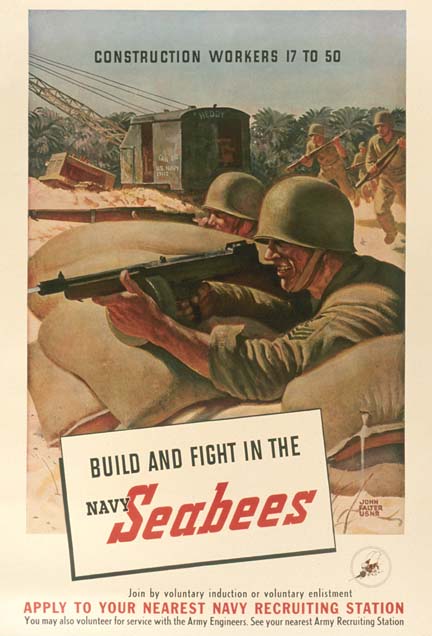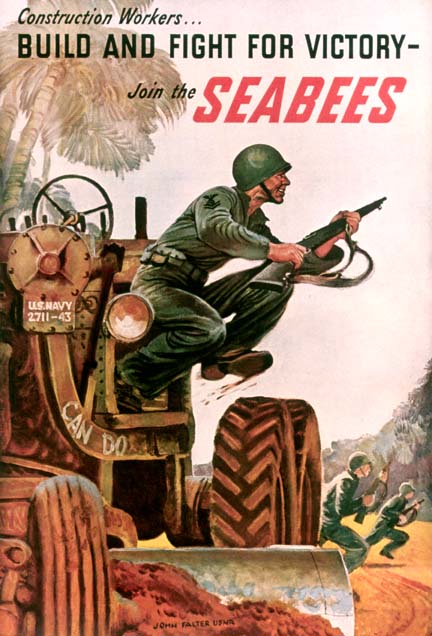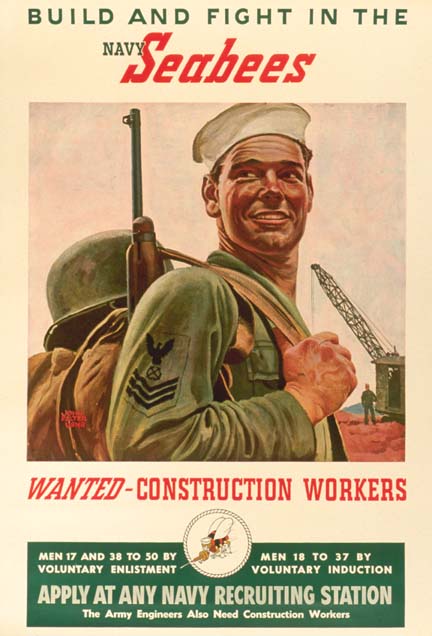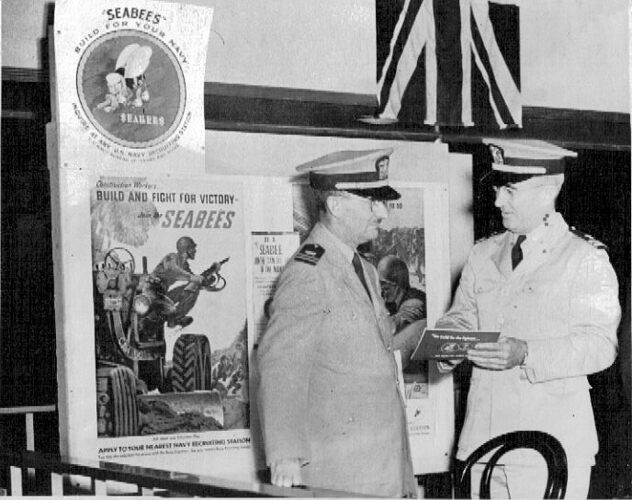My Dad was in the Seabees in the Pacific. He was in New Guniea, Philippines, and China. Would be interested in hearing from any former Seabees or the children of Seabees .
My father was in the Seabees during WW2. I also know a few WW2 Seabees What battalion was your father in?
My Dad was in the 122nd Seabees. I believe he went in in 1943 and got out sometime in 1946. What battalian was you father in? What years did he serve? How about those other guys, what do you know about their service?
http://carol_fus.tripod.com/navy_hero_6th_ncb.html Link to Pops Unit.
122nd Seabees - After formation at Peary in October 1943, the 122nd NCB was transferred to Camp Parks, then to Port Huneme on December 28. It left the states Feb. 21, 1944 and arrived at Milne Bay, New Guinea. The battalion operated at Gamododo, Milne Bay, until alerted for Hollandia in May 1944, where it was operating until December 20. On that date, the 122nd left Hollandia for Samar, and was stil there in August 1945.
Yes, your information is correct! As an addition, some members of the 122nd ended up in Tientsein, China as occupation troops, my father among them. You didn’t answer my question though about your father’s service. What unit was he in? What years did he serve? What was his occupation?
I gave you the link to his unit - 6th Special Seabees 2nd Section
Sorry about that, I didn’t see it. Thanks.
I just checked it out. Looks like he was at some of the same places my Dad was at and at the same time. A couple of years ago, I took my Dad to the dedication of the WW2 Memorial in D.C. It was a enjoyable day. We met a few other Seabees there. It was nice to talk with those guys. My Dad was a Carpenter’s Mate, he worked on building the hospitals etc. He was sure glad those 2 “Bombs” were dropped on Japan. He would have been in the invasion.
The Seabee “Specials” were Stevedores - and many were used as "shore parties"Loading and unloading ships on the beachheads and then moving the cargo to inland supply dumps. Other than their campsites and ramps for the ships to help facilitate entry, they really didn’t build anything unless called upon to do so.
Yep, I had heard about that unit. I had heard it was developed because they were have a problem with an inefficient unloading process, and they needed some experts. The Navy really did a good job in coming up with the Seabees. All the stuff that their engineers developed, stuff like those floating docks etc. It’s all pretty interesting. It would have been hard to win the war without them.
I am very interested in both the Seabees and the Army Engineers. Their contributions were invaluable to the success of the war. Forgive the length of the post, but I found some stuff I wanted to share with you about the Army’s experiences with unloading equipment off the boats before a better system of organization was put in place. It underscores the valuable contribution of the “Stevadore” Seabees. I’ll also post more in relation to the contribution of the Engineers of the 25th because it corresponds with what Laconia’s father did as a Seabee. I hope it’s okay with you both that it’s not specifically about Seabees? I’ll be going to the a large bookstore tomorrow, so I’ll look for books about them. I don’t currently own any since I’ve been concentrating on the Army. I’ve only been learning about WWII since December 12th 2006 and I’ve only got two books and two DVD’s about WWII so far. That will all change tomorrow, though. BOOKSTORE RAID!!!:twisted:
My Great Uncle was in the Army, 25th I.D./161st Infantry Regiment (a Washington National Guard Unit). He enlisted in the Army in San Francisco, CA on August 6, 1941. He was discharged in the spring of 1946. He saw a lot of combat and distinguished himself in battle on more than one occasion. The 25th “Tropic Lightning” Division during WWII was composed of the 27th Infantry, the 161st Infantry, and the 35th Infantry. The 25th was present (in some form or another) at Pearl Harbor, Guadalcanal, New Georgia, Arundel, Kolumbangara, Vella Lavella, Luzon, Philippines, and Japan. The 161st fought on Guadalcanal, New Georgia, Luzon, Philippines and was on occupation duty in Japan. They were named “Tropic Lightning” for their swiftness and excellence in accomplishing their goals. Here is a passage from the book “The 25th in WWII” originally published in 1946, reprinted by the Battery Press, Inc. in 1995. Regarding the unloading of supplies:
“The 35th Regimental Combat Team became the first unit of the Division to hit the beaches of Guadalcanal, landing near the Tenaru River on 17 December, 1942. Supplies came ashore by way of Higgins boats and “daisy chains”. The tension of the initial landing gave way under the hours of work required to move the equipment from the landing craft and to consolidate it on shore.” This is the politically correct version, but it is does an okay job of what they faced after debarking in the crushing heat of Guadalcanal.
My Uncle’s unit, the 161st arrived on December 30, 1942. Here is a passage about the unloading of supplies from the book “Across the Dark Islands: the War in the Pacific” by Floyd W. Radike (published posthumously) He was a Lieutenant in Company B at that time and later went on to become a Brigadier General. He never intended to publish these memoirs, which is why I believe his entire book is probably one of the most truthful accounts of an infantryman’s experience ever published:
"Chaos is the best description for the condition on the beach. Piles of bags, stacks of footlockers, and assorted boxes were everywhere, including the water. Lighters were coming in continuously. As the ramps crashed down, teams of men rushed in and carried off the cargo, depositing it on the first available square yard of unoccupied beach. Then the ramps clanked up, the motors roared, and the lighters backed out for another load.
The XO was a man besieged. The heat, the confusion, and the babel of voices had unnerved him. The slick, competent officer who had briefed us at Nandi had given way to a sweating, irritable tyrant who roared and gesticulated out of sheer, towering frustration…The following day we continued looking for our baggage. We never did figure out why it had been spread out all over the beach; after all, it had been loaded according to a plan that was supposed to ensure it being kept together in the debarkation area. The only trouble was that the sailors unloading the hatches and the skippers operating the landing craft hadn’t heard of the plan. The era of efficient debarkation or landing plans had not come." December 30, 1942
If you are interested in seeing a picture of the road the Army Engineers built, I started a thread about Pictures of the Pacific in WWII. 
Hey Everyone,
I am new to this thread. I need help… My Grandfather was a Seabee
on the NCB 1059 unit, but there isn’t a whole lot of information out
there on the internet:( . I am looking for anyone who knows anything
about the 1059 and perhaps any surviving members. I have some cool
photo’s but don’t have many names with them. I know he was in Guam
in an Automotive repair facility… Any ideas where I should be digging
for additional info?
Thanks in advance for any help you can offer.
God Bless and Keep
CHamilton
P.S I have sent for his files from NARA… weeks ago… still nothing
yet!!!
Well, how about posting a few of those photos. i would like to see them. Here is my Dad on a dozer, and my Dad in New Guniea.
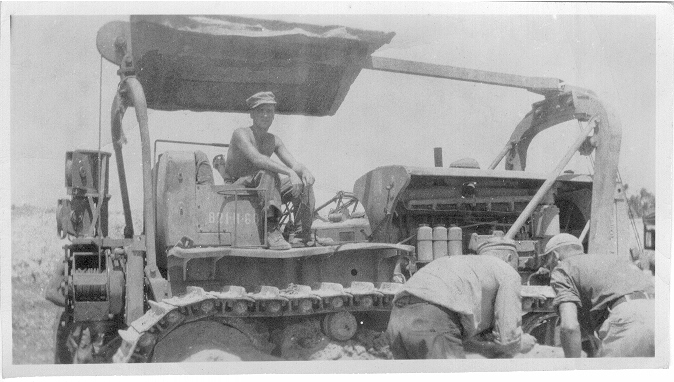
Ok I will try to post the pictures. I am not very good at this but I will
try. Thanks for sharing yours. I enjoyed seeing them. My grandpa is
the one in the jeep and sitting on the front row (left). Enjoy
Ok, the pic’s didn’t stick. I will try again…
[QUOTE=Chamilton;95088]Here we go again. I am going to attempt posting these pics… hope it
works.
Good deal, you got it! I see your Grandpa was a Lieutenant. Good pics. In the Air Force 2 bars were a Captain. He looks in his 50’s. Do you know how old he was back then?
Hello,
Sorry for the delay in reply.
Yes, Grandpa was eventually a Lt. Commander. He was 44 in this picture.
He went in at 43 yrs old… pretty old by todays standards, but the Seabees
took men with the needed experience and he had lots of that.
40th Seabees at Los Negros
In March 1944, on Los Negros island in the Admiralties, just north of eastern New Guinea, the 40th Seabee Battalion was assigned to the 1st Calvary Division of the Army. Its objective was to put the unused and much bombed Japanese airstrip at Momote into operation. The army captured the airfield, all right, but while the Seabees were at work on it, the Japanese counterattacked in greater force than anyone suspected was present. Two Seabee officers and 100 men took over a sector of the perimeter and occupied a trench that they dug with the battalion’s ditch digger. They armed themselves with automatic rifles and knives, and set up a truck mounted 20 mm gun behind them. Meanwhile other Seabees landed and started to grade and clear the runways and taxiways in the midst of battle. Others drove bulldozers into the jungle to clear fire lanes for Army guns, using the blades now to clear a lane and again raised as a shield, behind which they fired at the enemy. In the Japanese assault, the Seabees distinguished themselves by capturing two machine gun positions and a Bofors gun. They took 47 casualties, with nine killed. General Macarthur awarded them the Army’s Distinguished Unit Badge, and President Roosevelt gave them the Presidential Unit Citation
That was a good account. Shows that the Seabees could really fight if they had too. My Dad was never fired upon, but he said that when he went for walks away from base, he always carried a .30 carbine - just in case he ran into some Jap holdovers who had escaped into the bush.
I have the official ‘thumbnail history’ of the Seabee units in WWII. This is called, “SEABEES Where they worked and fought in World War II - An official brief of the itinerary of all the organized U. S. Naval Construction Battalions and special units”. This file is 67 pages long in Adobe PDF format. It is a re-typing of a similar document dated October 1945.
Regarding unit CBD 1059 here is the history >> “CBD 1059 was formed at Camp Peary and arrived at Port Hueneme in April 1944. The unit shipped overseas Oct. 11, 1944 and landed at Guam on Nov. 8. The outfit’s principal work at Guam was to operate a large tire repair and recapping shop. In September 1945, the detachment remained at Guam.”
If interested send request to >> larrydev@earthlink.net

